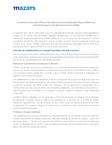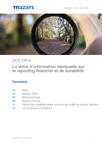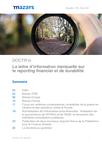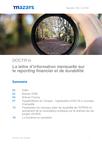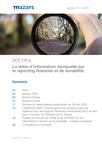
IFRS news from the International Accounting Standards Board (IASB) and European Securities and Markets Authority (ESMA)
IFRS news from the IASB and ESMA
As the half-yearly closing approaches, we would like to present you a list of the new applicable texts as of 1 January 2022, both mandatory and optional. This overview is completed by the presentation of the ESMA recommendations published on 13 May. The European stock exchange supervisor has identified some aspects regarding the financial statements from 30 June in the context of the Russian invasion of Ukraine. ESMA has also issued specific guidance in the context of the upcoming implementation of IFRS 17 on insurance contracts.
Follow-up of re-deliberations on the project Presentation of financial statements
At the May 2022 meeting, the International Accounting Standards Board (IASB) continued to re-deliberate the proposals contained in the December 2019 ‘General Presentation and Disclosures’, following comments received from stakeholders.
Performance measures selected by management
In particular, the IASB continued its deliberations on the subject of Management Performance Measures, which are the measures with which an entity communicates outside its IFRS financial statements and for which the IASB wishes to set a framework, with a certain number of mandatory disclosures to be made in the appendix.
In particular, the re-deliberations to date have confirmed the Exposure Draft's proposal to introduce a minimum list of mandatory disclosures, to be included in a single note to the financial statements, for all of the MPMs used by the company, to promote transparency in the communication of these measures. As part of this disclosure requirement, an entity should provide a reconciliation between an MPM and the most directly comparable subtotal or total income statement.
However, a controversial proposal in the Exposure Draft, namely the requirement to determine the tax effect and the effect on non-controlling interests of each reconciling item, still needed to be re-decided. At its May 2022 meeting, the International Accounting Standards Board (IASB) decided to adopt the proposal ‘General Presentation and Disclosures’, with changes to how the tax effect will be presented.
Unusual income and expenses
The re-deliberations on this subject started last December. In May, the IASB arrived at the following definition of unusual income and expenses, which are now classified as "limited recurrence" income and expenses: „Income and expenses have limited recurrence when it is reasonable to expect that income or expenses that are similar in type and amount will cease, and once ceased will not arise again, before the end of the assessment period.”
The IASB also started in May to review the disclosures to be made in a dedicated note to the financial statements on limited recurrence income and expenses. Discussions will continue at a later stage based on further analysis by the staff about the new definition of these revenues and expenses.
IASB suspends its project on IAS 19 pension benefits that depend on asset performance
From 2018 to 2021, the International Accounting Standards Board (IASB) studied the feasibility of an amendment to IAS 19 Employee Benefits, to address the case of retirement benefits that are linked to the performance of certain assets, for example, the return on shares or bonds.
The IASB has now announced the suspension of this project on the grounds that its research did not provide sufficient evidence that pension benefits that depend on the performance of specified assets are widely used in all jurisdictions. In particular, the IASB concluded that the cost of implementing any changes outweighed the potential benefit of improved financial reporting. The IASB is also aware that such an amendment would introduce the capped approach, being thus an exception from the measurement requirements under IAS 19.
Hyperinflation in Turkey: IAS 29 application back on the agenda
The half-yearly closing of 2022 is marked by the application of the provisions of IAS 29 for drafters of significantly exposed accounts in Turkey, following the qualification of the country as a hyperinflationary economy under IFRS as of 1 April 2022. On 16 March, the International Practices Task Force (IPTF) of the Center for Audit Quality (CAQ), the usual reference for identifying hyperinflationary countries, published a working paper that included this country in the list of hyperinflationary economies.
The implementation of IAS 29 requires the restatement of the financial statements of an entity whose functional currency is denominated in a hyperinflationary currency. These provisions take effect from the beginning of the financial year in which the existence of hyperinflation is identified.
In the case of Turkey, IAS 29, therefore, applies from 1 January 2022 for entities with a calendar year closing and having the Turkish lira as a functional currency, for the preparation of interim and annual accounts. More generally, all accounting periods including 1 April 2022 are affected by the application of IAS 29 for the restatement of operations in Turkey.
End of IRP IFRS 10, 11 and 12
At its February meeting, the International Accounting Standards Board (IASB) terminated its post-implementation review of IFRS 10, IFRS 11, and IFRS 12 on consolidation, concluding that none of the topics identified in the review were of sufficient priority to merit inclusion in its work programme for the next five years. If necessary, some topics may be reconsidered in the context of the IASB's forthcoming consultation on its post-2026 work programme. Stakeholders are therefore encouraged to refer to the IFRS Interpretations Committee (IFRS IC) if there are practical implementation issues that need to be addressed in the short term.
A report and feedback statement will be published shortly to present the work performed under the review and the decisions taken by the Board.
ESMA: 26th extract from the IFRS implementation decisions database
On 17 May, as is now customary and without a set frequency, the supervisor of stock exchange regulators in Europe, the European Securities and Markets Authority (ESMA), published the 26th extract from its database of decisions taken by regulators in the European Economic Area (EEA) in relation to the implementation of IFRS.
The 11 rulings published in this 26th extract relate to annual financial statements for 2018, 2019, and 2020, and cover the following topics: a review of credit increases in the measurement of expected credit losses (IFRS 9), measurement of the net realisable value of inventories (IAS 2), costs of sales in the calculation of the net realisable value of inventories (IAS 2), recognition of deferred revenue (IFRS 15), significant financing component (IFRS 15), presentation of litigation income as revenue (IFRS 15), impairment testing of a cash-generating unit (CGU) that includes rights of use of assets (IFRS 16/IAS 36), impairment indicators related to the COVID-19 crisis (IAS 36), identification of CGUs (IAS 36), operating segments (IFRS 8), changes in the composition of cash and cash equivalents (IAS 7/IAS 8).
ESMA recommendations (and their translation by the AMF) on the first-time application of IFRS 17 on insurance contracts
IFRS 17 on insurance contracts was adopted by the European Union earlier this year and will be applied for the first time on 1 January 2023.
While this standard prescribes first-time application disclosures (explanations of impacts on 2023 financial statements and prior periods presented), which are disclosed for the first time in the first interim financial statements published in 2023, IAS 8 requires disclosures about the roll-out of the future standard and its expected impacts, pending the actual application.
In this context, ESMA published on 13 May the recommendations concerning the information to be provided by insurers regularly between now and the entry into force of IFRS 17.
ESMA and AMF communicate on certain points of concern for the 2022 half-yearly financial reports in relation to the Russian invasion of Ukraine
On 13 May, ESMA issued a statement detailing certain points of concern for the preparation of the 30 June financial reports (which include the IFRS financial statements and the half-yearly management report) in the particular context of the Russian invasion of Ukraine. In practice, these recommendations may also concern annual accounts (in the case of a staggered closing).
Standards and interpretations applicable as of 30 June 2022
In this period of half-yearly closing, we present an overview of the latest texts published by the IASB. We specify which texts are mandatory and which can be applied early, taking into account the status of the European adoption process, as updated on the EFRAG website on 2 May 2022.
To discover our studies, consult our explanatory newsletters and documents available online!

